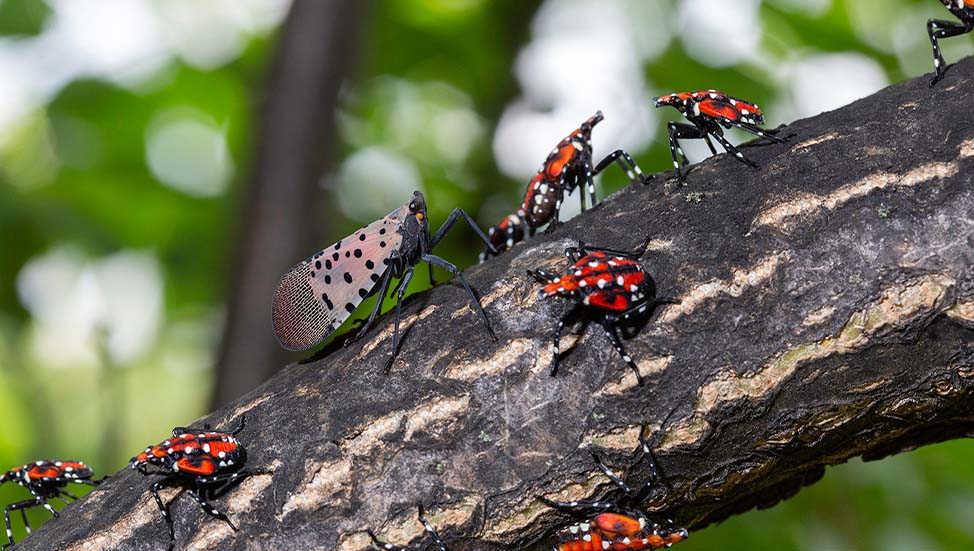Are Spotted Lanternflies Harmful to Pets?
I think my dog just ate a spotted lanternfly. Should I take him to the vet?

If you’ve never heard of the spotted lanternfly, you’re not alone. Unfortunately, you may be hearing about them soon because they pose a serious economic threat to many fruits, vegetables, and trees, including grapes, cherries, apples, black walnut, maples, tulip poplar, and many more. The official count is something like 70 different plants that are impacted by this insect.
Native to India, China, and Vietnam, the spotted lanternfly came to the public eye in 2014 when discovered in Berks County, PA. Since then, they have been found in New York, New Jersey, Delaware, Massachusetts, and Connecticut. However, scientific experts believe that unless controlled now, these dangerous insects will spread and wreak havoc in many other areas in the United States.
Are they Dangerous Insects?
The question we pet owners have is, are these insects harmful to our cats and dogs? Unfortunately, there are still many unknowns since the lanternfly is so new on the scene. Researchers are just beginning to get a handle on all aspects of this insect, including how they can affect our pets. But the good news is, we know enough to be able to keep our pets safe.
First, and most comforting, it appears that these critters do not pose any major harm to our pets. However, some potential issues need additional study and research. In the meantime, here’s what we do know about pets and the spotted lanternfly, and what precautions we should take.
Biting or Stinging?
These insects do not harm animals or humans by stinging, as they do not have a stinging mechanism. Their mouth is like a straw that penetrates its food and then sucks it in. Simply put – no stinger!
Foot Blisters?
There have been some reports that dogs and cats have gotten foot blisters by walking on the lanternfly, but these reports are unsubstantiated.
Seizures?
Like the foot blisters, some people have attributed their pet’s seizure activity to the lanternfly, but also, like the blisters, these reports appear to be anecdotal. It’s likely the seizures have some other cause.
Are They Poisonous?
Birds generally thrive on insects, but researchers have found that at first birds tended to avoid the lanternfly. The question is why? And the next question is, what does this mean for our pets? Some veterinarians have reported that pets who ingested these insects developed drooling, stomach upset, and loss of appetite. On the other hand, there are a host of other substances that could cause the same symptoms.
What researchers have found is that the lanternfly is attracted to plants containing toxic compounds which could be passed on to pets who eat the insect. This has not been proven but is a good reason to keep your pet away from these insects. In addition, a concentrated movement is underway to eradicate the lanternfly with insecticides, which are poisonous to pets and another reason to avoid the insect.
Eating Lanternflies?
What if your pet does eat one? If you are aware of it, keep an eye on him. Watch for drooling, vomiting or loss of appetite. If you notice any of these symptoms, or if you are just generally concerned, be sure to call your vet.
What About Wildlife?
At first, researchers found that birds tended to avoid eating the lanternfly, but now, increasing numbers are ingesting them. However, researchers have also found that some birds vomit after eating them. Still, other birds remain unharmed. No additional reports have come in about other wildlife becoming ill or injured because of lanternflies.
A Dog’s Role
Ironically, dogs are being trained to assist in the eradication of these dangerous pests. Specifically, they are trained to spot the lanternfly’s egg masses before they can hatch and add to the hazard of an increasing population. The dogs are being trained at the University of Pennsylvania and the success rate of this program so far is 95 percent.
Despite the many unknowns about the spotted lanternfly, enough reports indicate that it is safest to keep pets far from this insect.
Ready to start saving money on pet wellness care?
Then take a look at Mint Wellness, the pet wellness plan that provides fast reimbursement on routine pet care. Save on vaccinations, wellness exams, preventatives, dental, and more!
Learn More


